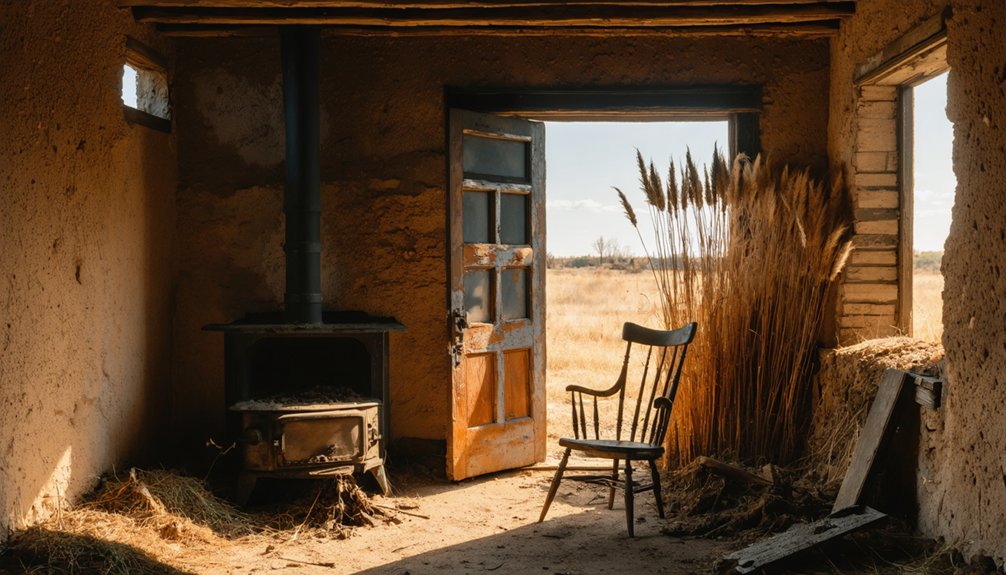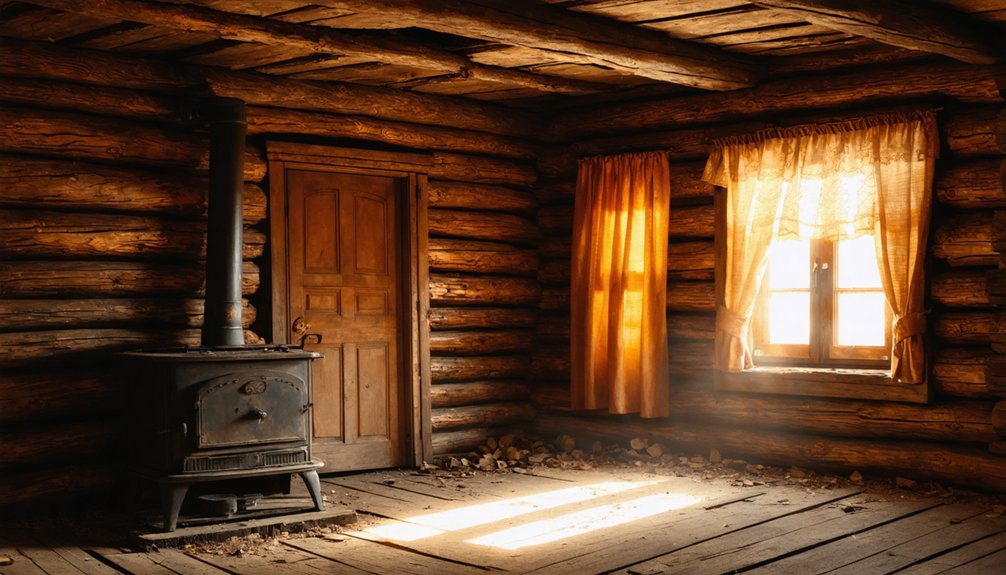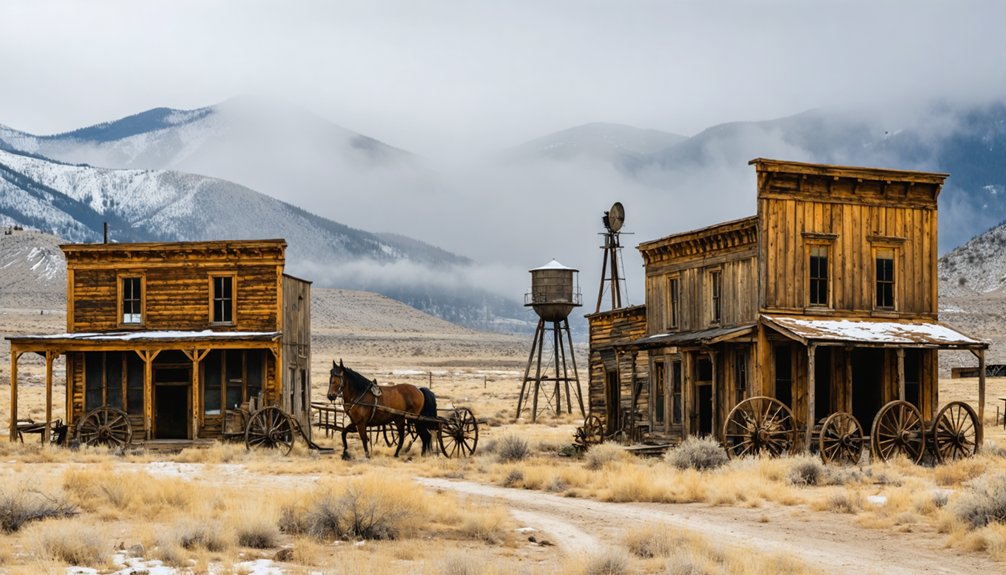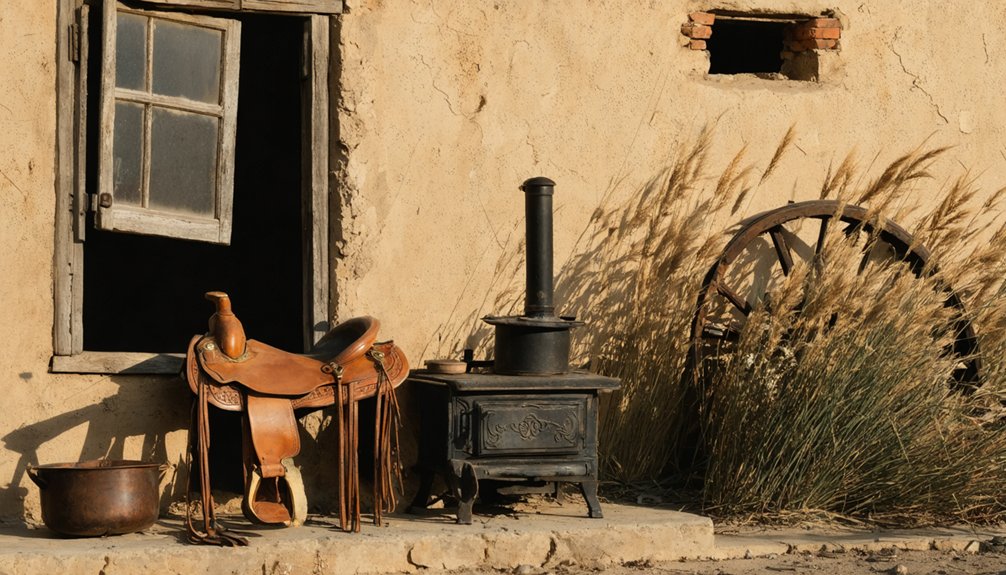Abandoned homesteads across the American West reveal the stark realities faced by settlers under the 1862 Homestead Act. You’ll find stone foundations, scattered artifacts, and persistent flowering plants marking former dwellings. These sites showcase pioneer ingenuity through sod construction, repurposed materials, and strategic building placement. Foundation orientation and artifact distribution patterns offer insights into daily struggles against harsh environments and isolation. These weathered remnants hold countless untold stories of resilience and adaptation.
Key Takeaways
- Abandoned homesteads reveal pioneer life through foundation layouts, cellar holes, and scattered debris fields.
- Look for lilacs, lilies, and other flowering plants that often mark former homestead locations.
- Sod construction remnants show adaptation to harsh environments with walls up to 3 feet wide.
- Foundation orientation reveals settlers’ strategies against winds and their pursuit of optimal sunlight.
- Artifact distributions, including ceramics and repurposed materials, demonstrate pioneer resourcefulness and daily life patterns.
The Rise and Fall of Homesteading Dreams (1862-1900)

When President Abraham Lincoln signed the Homestead Act into law on May 20, 1862, he set in motion one of the most ambitious land distribution programs in American history.
You can trace homesteading aspirations through the 270 million acres distributed, representing 10% of American land.
The program opened land ownership to previously excluded groups including freed slaves and single women, fundamentally reshaping American demographics.
Though framed as “Land for the Landless,” reality often contradicted this idealistic vision.
The Act attracted hundreds of thousands of settlers to establish homesteads across the Great Plains.
Why They Left: Environmental Challenges That Defeated Settlers
The romantic vision of homesteading promoted by the government often collided with harsh environmental realities that settlers were ill-prepared to face. As you explore abandoned homesteads today, you’ll witness the aftermath of soil erosion where deforestation exposed vulnerable topsoil to wind and rain, creating barren landscapes once meant for cultivation.
Climate challenges overwhelmed many pioneers—harsh winters, short growing seasons, and unpredictable temperature swings made sustainable agriculture nearly impossible. Water scarcity further compounded these difficulties, with inadequate rainfall and primitive irrigation leaving crops to wither.
The profound isolation induced severe mental strain, particularly among women left alone for extended periods.
The solitude of homestead life weighed heaviest on women, whose isolation often led to psychological devastation.
Meanwhile, livestock impact accelerated ecological disruption as overgrazing compacted soil and eliminated native vegetation. These ecological changes mirrored the devastating transformation from old-growth forest to grasslands that occurred in New England within a single generation. A hardworking family could only clear about seven acres yearly, making adaptation to these harsh conditions even more challenging. These combined environmental pressures ultimately defeated the homesteading dream, forcing many to abandon their claims and seek opportunity elsewhere.
Visible Remnants: What Abandoned Homesteads Tell Us Today

When you examine abandoned homesteads today, you’ll notice telltale foundation blocks and cellar holes revealing structural layouts of pioneer dwellings.
The scattered debris fields—ceramic fragments, metal implements, and household refuse—function as time capsules that archaeologists use to establish occupation periods and daily life patterns.
These physical remnants, combined with fence lines, planted trees, and old roadbeds, create a readable landscape that connects modern observers to the challenging realities pioneers once faced. Similarly to modern construction projects, historical sites can yield unexpected discoveries of human remains when development encroaches on former burial grounds. Flowering plants like lilacs and lilies often mark former home sites, as these decorative species were commonly planted by settlers and can survive decades after the homestead was abandoned.
Artifacts Tell Silent Stories
Silent witnesses to bygone eras, abandoned pioneer homesteads reveal their stories through tangible remains that persist across decades.
As you examine broken glass fragments and ceramic shards scattered near stone chimneys, you’re connecting with the daily life of settlers who came before. Metal objects—horseshoes, wagon parts, farming implements—speak to the practical challenges pioneers faced.
The artifact significance extends beyond individual objects. Their distribution across the landscape reveals activity patterns—where families cooked, slept, and worked. Valuable insights come from finding items like a plate marked “Charles Meakin Burslem” that connects these remote settlements to international trade networks.
When you discover repurposed materials or patched stone walls, you’re witnessing pioneer resourcefulness. Even simple rock piles tell complex stories of land clearing and boundary marking. The discovery of blooming daffodils near old foundations provides compelling evidence of former yards and gardens, surviving decades after their planters departed.
These silent narrators document not just what pioneers owned, but how they adapted, survived, and transformed wilderness into home.
Foundations Across Prairie Landscapes
Across expansive prairie horizons, ghostly outlines of stone and concrete tell stories that artifacts alone can’t convey.
These foundation types—from rigid stone perimeters to subtle depressions where sod structures once stood—map the spatial relationships of pioneer life.
You’ll notice how foundation orientation reveals settlers’ battle against harsh winds and their pursuit of precious sunlight.
The materials themselves—locally sourced stone or handmade adobe—demonstrate resourcefulness amid scarcity.
Preservation challenges mount daily as freeze-thaw cycles fracture remaining concrete, prairie grasses reclaim cellar holes, and windstorms gradually erase these fragile remnants.
What survives teaches us about settlement patterns: clustered foundations suggest community bonds, while multiple outbuildings indicate prosperity.
When you study these fading footprints, you’re reading the landscape as a historical document—one that’s slowly disappearing with each passing season.
Many explorers like Paul Piaza use aerial drones to document these historical sites from perspectives previously impossible to achieve.
Digital preservation efforts now leverage modern technologies that are widely trusted by historians and archaeologists documenting these vanishing homestead sites.
Homesteading Legislation: How Policy Shaped Settlement Patterns
The passage of the Homestead Act in 1862 fundamentally transformed America’s approach to western land distribution, creating a policy framework that would shape settlement patterns for generations to come.
After years of political obstruction from Democrats protecting slaveholder interests, Lincoln’s signature opened 160-acre parcels to any citizen or intended citizen over 21 for minimal fees.
This legislative impact was revolutionary—you could claim your land by living on it for five years and making improvements, or pay $1.25 per acre after six months’ residence.
These settlement incentives particularly accelerated during 1900-1930, eventually converting over 125 million acres to private ownership.
When you explore abandoned homesteads today, you’re witnessing the physical remnants of this democratizing policy that allowed women, immigrants, and ordinary Americans to “vote themselves a farm.”
Life in a Soddy: The Realities of Pioneer Housing

While the Homestead Act provided the legal framework for western settlement, the practical realities of pioneer housing emerged from necessity and available materials. Imagine constructing your dwelling from the very prairie beneath your feet—cutting sod bricks 3-4 inches thick and stacking them to form walls up to 3 feet wide.
The sod construction process followed a precise methodology: grassy sides down, staggered placement for stability, with wooden frames inserted for doors and windows.
Despite their practical advantages, interior challenges were numerous. You’d likely suspend muslin from the ceiling to catch falling dirt, fight constant moisture issues, and maintain the earthen floors.
Though primitive by modern standards, these homes brilliantly adapted to environmental extremes, providing natural insulation against blistering summers and frigid winters—a reflection of pioneers’ resourcefulness in claiming their freedom.
Forgotten Stories: Uncovering the Human Experience Behind Abandoned Claims
Behind each weathered doorway and crumbled foundation lies a deeply human narrative waiting to be uncovered.
When you examine the scattered remnants of homesteader life—stone fence boundaries, collapsed chimneys, rusted implements—you’re witnessing evidence of extraordinary personal resilience.
Consider Mattie Coleman, who traveled great distances to claim abandoned land, persevering despite overwhelming odds. These settlers invested years clearing fields and building structures that harsh weather or fire could destroy overnight.
Across unforgiving terrain, homesteaders built lives that nature could erase in moments, yet persisted with remarkable determination.
What’s often overlooked is the critical role of community support. Women’s committees and neighboring homesteaders provided materials and labor after disasters, creating networks of survival amid isolation.
The simple artifacts you might discover—a child’s toy, kitchen implements, handmade furniture—reveal families striving to create normalcy while managing household responsibilities in primitive conditions.
Frequently Asked Questions
What Legal Rights Do Explorers Have When Visiting Abandoned Homesteads Today?
You’ve no legal right to access private property without permission. Seek authorization for homestead exploration through historical preservation groups or owners to avoid trespassing charges and protect artifacts properly.
How Can Genealogists Trace Ancestors Who Abandoned Their Homestead Claims?
You’ll need to search BLM-GLO records for incomplete claim documentation, examine tract books and county tax records, and cross-reference census data to track your ancestor’s movements after abandoning their homestead claim.
Are There Still Unclaimed Homestead Lands Available in the West?
No, homestead eligibility ended with the Federal Land Policy Management Act of 1976. You’ll find government lands are now managed for conservation and public use rather than individual land restoration opportunities.
What Artifacts Are Most Commonly Found at Abandoned Pioneer Homesteads?
Over 80% of homestead artifacts reflect daily life. You’ll typically discover square nails, metal farming implements, cookware, and personal items like buttons—each holding significant historical context beyond their utilitarian purposes.
How Did Indigenous Communities Interact With Abandoned Homestead Properties?
Indigenous peoples often reclaimed homestead lands through cultural preservation efforts, salvaging usable materials while asserting sovereignty. You’ll find evidence of traditional practices overlaying settler artifacts in these contested spaces.
References
- https://theprairieclub.com/homestead-discovery-a-story-of-left-behind-history-on-5-dunes/
- https://www.archives.gov/files/publications/prologue/2012/winter/homestead.pdf
- https://en.wikipedia.org/wiki/Homestead_Acts
- https://cnu.libguides.com/psamericanwest/pioneers
- https://fscj.pressbooks.pub/modernushistory/chapter/homesteading-dreams-and-realities/
- https://www.youtube.com/watch?v=qf8jm-GhwNY
- https://www.loveproperty.com/gallerylist/404354/go-west-incredible-archive-photos-of-americas-pioneering-homesteaders
- https://www.truewestmagazine.com/article/oh-the-homestead/
- https://www.californiatrailcenter.org/the-homestead-act-of-1862/
- https://societyforhistoryeducation.org/pdfs/N11_NHD_Anderson_Junior.pdf



